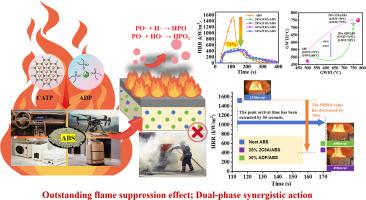聚簇式烷基膦酸铝复合阻燃体系增强丁苯共聚物防火安全性的机理
IF 7.4
2区 化学
Q1 POLYMER SCIENCE
引用次数: 0
摘要
本研究将具有簇聚特性的烷基膦酸铝(CATP)阻燃剂与二乙基膦酸铝(ADP)相结合,构建复合阻燃体系,对丙烯腈-苯乙烯-丁二烯(ABS)进行阻燃改性。系统地研究了该体系的阻燃性能和阻燃机理。结果表明,当CATP/ADP质量比为2:8,总负载为28 wt. %时,ABS复合材料的LOI值为35.6%,通过UL-94 V-0额定值。锥量热计测试表明,与纯ABS相比,CATP/ADP的峰值放热率(峰值放热率)和总放热率(总放热率)分别降低了73%和40%。对其阻燃机理的研究表明,CATP/ADP在分解过程中释放PO•自由基,猝灭了气相的燃烧链式反应。同时,CATP促进了覆盖基底的连续致密炭层的形成,抑制了传热。此外,磷(P)和铝(Al)元素在该炭层中富集,增强了其阻隔作用。这证明了两相协同阻燃效应涉及气相和凝聚相机制。在灼热丝试验中,CATP/ADP/ABS样品的灼热丝着火温度(GWIT)和灼热丝可燃性指数(GWFI)分别达到750℃和775℃。与纯ABS相比,这是一个显著的改进,表现出优异的消防安全性能。力学性能方面,复合体系的抗拉强度(26 ~ 27 MPa)高于单一ADP体系(21 ~ 22 MPa)。然而,由于橡胶相结构的破坏,冲击强度降低(7.3 ~ 7.7 kJ/m2)。综上所述,本研究为开发高性能无卤阻燃ABS提供了理论基础和技术支持。本文章由计算机程序翻译,如有差异,请以英文原文为准。

Clustered aluminum alkylphosphinate composite flame retardant system enhancing mechanism of fire safety in styrene-butadiene copolymer
This study constructed a composite flame-retardant system by combining an aluminum alkylphosphinate flame retardant with cluster aggregation characteristics (CATP) and aluminum diethylphosphinate (ADP) for flame-retardant modification of acrylonitrile-styrene-butadiene (ABS). The flame-retardant performance and mechanisms of this system were systematically investigated. The results indicated that when the CATP/ADP mass ratio was 2:8 with a total loading of 28 wt. %, the ABS composite achieved an LOI value of 35.6 % and passed the UL-94 V-0 rating. Cone calorimeter tests revealed that the peak heat release rate (pk-HRR) and total heat release (THR) were reduced by 73 % and 40 % respectively, compared to neat ABS. Investigation into the flame-retardant mechanism revealed that CATP/ADP released PO• radicals during decomposition, quenching the combustion chain reactions in the gas phase. Simultaneously, CATP promoted the formation of a continuous and compact char layer that covered the substrate, inhibiting heat transfer. Furthermore, phosphorus (P) and aluminum (Al) elements become enriched within this char layer, enhancing its barrier effect. This demonstrates a dual-phase synergistic flame-retardant effect involving both gas-phase and condensed-phase mechanisms. In the glow wire test, the glow-wire ignition temperature (GWIT) and glow-wire flammability index (GWFI) of the CATP/ADP/ABS sample reached 750 °C and 775 °C, respectively. This represented a significant improvement over pure ABS, demonstrating excellent fire safety performance. Furthermore, regarding mechanical properties, the composite system exhibits tensile strength (26–27 MPa) higher than that of the single ADP system (21–22 MPa). However, the impact strength decreases (7.3–7.7 kJ/m2) due to disruption of the rubber phase structure. In summary, this study provided both a theoretical foundation and technical support for the development of high-performance halogen-free flame-retardant ABS.
求助全文
通过发布文献求助,成功后即可免费获取论文全文。
去求助
来源期刊

Polymer Degradation and Stability
化学-高分子科学
CiteScore
10.10
自引率
10.20%
发文量
325
审稿时长
23 days
期刊介绍:
Polymer Degradation and Stability deals with the degradation reactions and their control which are a major preoccupation of practitioners of the many and diverse aspects of modern polymer technology.
Deteriorative reactions occur during processing, when polymers are subjected to heat, oxygen and mechanical stress, and during the useful life of the materials when oxygen and sunlight are the most important degradative agencies. In more specialised applications, degradation may be induced by high energy radiation, ozone, atmospheric pollutants, mechanical stress, biological action, hydrolysis and many other influences. The mechanisms of these reactions and stabilisation processes must be understood if the technology and application of polymers are to continue to advance. The reporting of investigations of this kind is therefore a major function of this journal.
However there are also new developments in polymer technology in which degradation processes find positive applications. For example, photodegradable plastics are now available, the recycling of polymeric products will become increasingly important, degradation and combustion studies are involved in the definition of the fire hazards which are associated with polymeric materials and the microelectronics industry is vitally dependent upon polymer degradation in the manufacture of its circuitry. Polymer properties may also be improved by processes like curing and grafting, the chemistry of which can be closely related to that which causes physical deterioration in other circumstances.
 求助内容:
求助内容: 应助结果提醒方式:
应助结果提醒方式:


